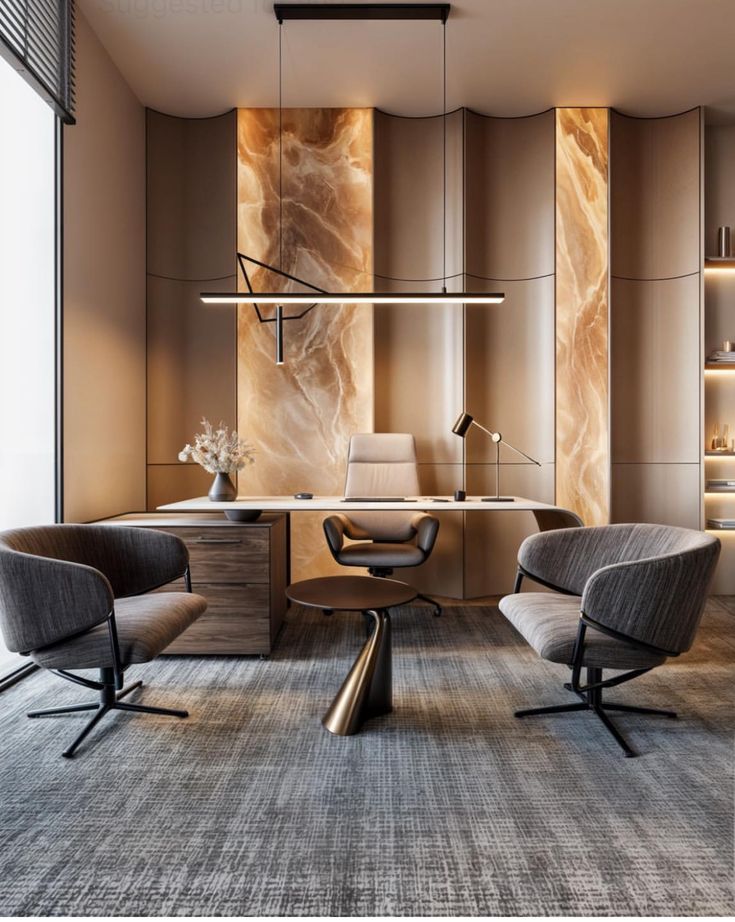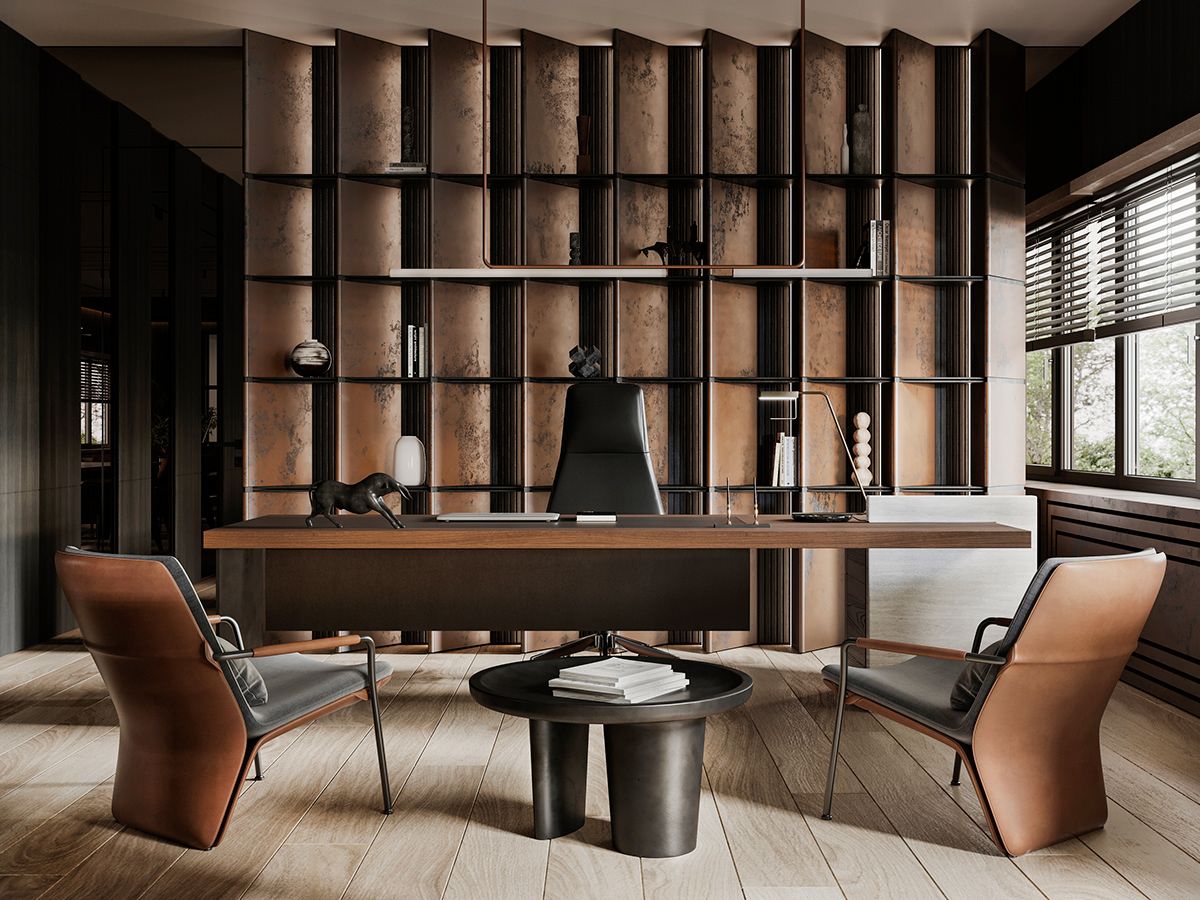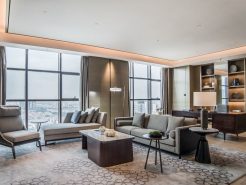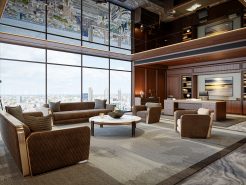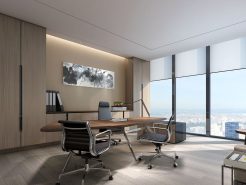Where a desk is placed in designing the chairman office is never a coincidence. It is an invisible map of power. It is the clearest expression of the psychology of the person holding the leadership position. Each desk position is a declaration of how they see the world. How they make decisions and how they want others to see them. This article will be a journey of discovery deep into where the power sits and the real psychology behind it!
1. The leader’s psychology is shown through the position of the table in designing the chairman office
Desk placed against the wall – Defensive mentality, control, supreme power
The position of the desk facing the wall is not simply a space arrangement. It also reflects a deep psychological layer of the leader. Defensive thinking and absolute control. Having no one behind brings a feeling of maximum security. As if all risks have been eliminated from the root. From here, the leader’s eyes can cover the entire space, all movements are controlled. This is a manifestation of a strong personality. There is a tendency to protect the system and structure that has been built. They are not easy to change, do not like to be put in a passive position. And always play the role of “final decision maker”. This leadership style tends to be decisive, tough and sometimes conservative. Like a general standing between strategy and defense. Controlling every detail to protect the interests of the organization in all circumstances.
Desk placed in the middle of the room or near the window – Open-minded, creative, far-sighted
Leaders choose to place their desks near the window or in the center of the room. They often carry a positive, extroverted and inspiring energy. This position does not create a distance from the surrounding environment. On the contrary, it is an invitation to dialogue, a bridge that opens communication.
They embrace natural light as they embrace new streams of thought. Breakthrough ideas. This is the type of leader with innovative thinking. Not afraid to experiment and always ready to step into the unknown to find opportunities. They are not bound by stereotypes. And believe in the power of collaboration, the ability to create value through connection. This leadership style strongly inspires the team. At the same time, it creates a culture of innovation and continuous learning. The typical image of the modern president. They are the ones who not only lead the company, but also change the way the world works.
Off-angle table – Flexible, cautious, multi-dimensional observation
When the desk is placed at an angle. Not in the center and not against the wall. That shows a leader with strategic thinking, flexibility and subtle observation. They do not show off their position, nor are they too rigid. Instead, they are proactive, knowing when to advance and when to retreat.
From this perspective, they can see the whole picture without being limited to a single perspective. This is the type of leader who is experienced, has been through a lot and understands that change is inevitable. They value psychological analysis, are skillful in dealing with people and are good at using people. This style is often seen in long-time senior managers. People who understand that power does not lie in the sitting position. But in the ability to read people and coordinate multi-dimensional strategies to maintain the balance between stability and innovation.(Proceedings – the journey begins from the president’s office).
2. Table position and the other person’s feelings – subconscious messages of power
Height of desk and guest chair
When the person opposite enters the room and notices that the chair of the host is significantly higher. While the guest chair is lower, even placed at a distance. A silent but extremely clear message of power is sent. This is the person “on top”, the one in control.
Sitting low makes customers feel smaller, more passive and sometimes have to “look up” to look at the leader. This is an action that symbolizes submission, respect or caution. This feeling is amplified if the desk is large, heavy, and dark in color. These factors invisibly create a psychological wall. Reinforcing the feeling of superior power of the leader in the eyes of customers and partners.
Leaders do not need to speak to assert their position. Because the spatial layout does it for them. For guests, this is the experience of “entering the territory”. Where they have to adjust their words, their behavior. And even their thinking to fit the established tacit order.
Distance between table and door
The position of the desk relative to the entrance is not only a matter of interior decoration. It also strongly affects the first impression of the person entering. When the desk is placed near the door. The leader can easily greet the guest with his eyes or words from the first moment. This contact creates a friendly, open feeling and helps shorten the distance between the two sides.
The close distance between the desk and the door helps to erase some of the “power barrier”. It makes the person opposite feel more approachable and comfortable sharing. On the contrary, when the desk is placed deep in the room, the guest is forced to “cross a path” before reaching the main communication point. This arrangement is like a hidden signal showing that the leader is selective in contact. A “power filter” makes them not easily approachable.
Each step closer becomes a silent test. A form of non-verbal evaluation. To the other person, this can create a sense of formality. But it can also make them more reserved and careful in their words and actions.
The direction the desk faces in designing the chairman office
The direction in which the desk rotates not only reflects personal feng shui elements. It also has a strong impact on the emotions and perceptions of the person opposite. When the table is facing the door, the leader is in an open position. It creates a feeling of welcome, positivity and approachability. Guests feel listened to and can easily enter the conversation without encountering any invisible barriers.
Conversely, if the desk is turned into a corner or has its back to the door, the person entering may immediately feel intimidated. As if they are intruding into a private space. Where everything is carefully controlled and there is no room for surprises. Leaders with this arrangement tend to be cautious, discreet and less forthcoming with their intentions.
Meanwhile, the desk is placed in a slightly tilted direction, not directly in front of the other person. It creates a sense of balance between distance and connection, between strategy and openness. This arrangement makes the other person feel that this person is flexible. Multidimensional thinking and knows how to calculate strategies. The conversation therefore has a more exploratory and analytical tone than a normal exchange.
Conclude
The position of the desk in the design of the president’s office not only reflects aesthetic taste. But also is a mirror reflecting the leader’s mindset. It does not say it, but reveals everything through the working space. A good leader does not just sit in a convenient place. But also knows where he is sitting and why he is sitting there. Because in a world where power is no longer in words, it is the space that speaks. Just by entering that powerful room, before even meeting the owner. We can somewhat feel the personality, style and thinking of the leader.
Learn more about the chairman’s office interior – Behind the billion-dollar table by Proce: Here!
=====\
PROCE – TOTAL LUXURY OFFICE SOLUTION
Website: https://proce.vn/
Youtube: https://www.youtube.com/@noithatvanphonghangsang
Fanpage: https://www.facebook.com/vanphongnhapkhauProce
GG Business: https://business.google.com/dashboard/l/15115233216900975876
Linkedin: https://www.linkedin.com/company/74359718/admin/
Hotline: 090.115.6767
#thiet_ke_phong_chu_tich; #home_office #; phong_lam_viec_tai_nha
#noi_that_phong_chu_tich; #phong_chu_tich; #thiet_ke_noi_that_phong_chu_tich
#noi_that_van_phong_cao_cap; #noi_that_van_phong_nhap_khau; #phong_hop
#phong_hop_chu_tich; #phong_lam_viec_chu_tich


